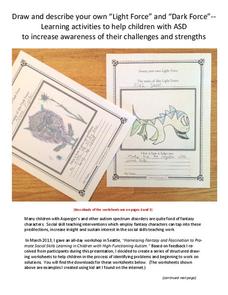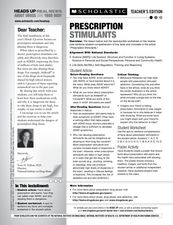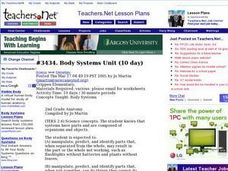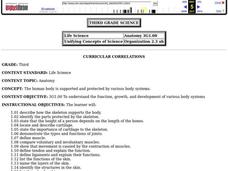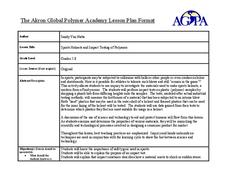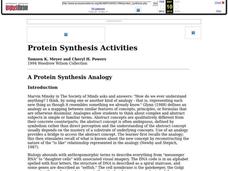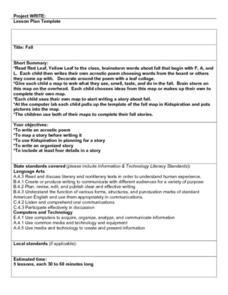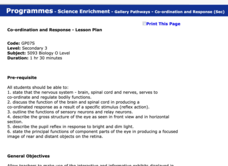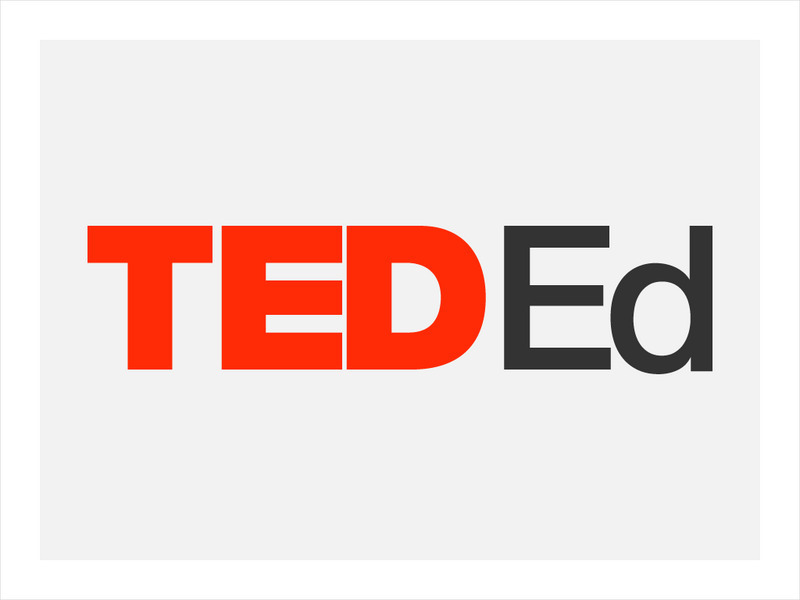University of Minnesota
Connect the Neurons!
Create a neuron frenzy as your pupils play the part of the neurons. An engaging lesson creates a human chain of neurons that pass cotton balls posing as neurotransmitters. Scholars learn about pre- and post-synapses as they complete...
University of Minnesota
Neurotransmission Model
Don't lose your marbles — you'll need them for a lesson on neurotransmission. Young scholars build a neurotransmission model using marbles, beads, rubber bands, string, and other elements. After studying specific neurotransmitters,...
Curated OER
“Light Force” and “Dark Force”
Designed for learners with autism, this set of worksheets prompts students to design their own fantasy characters as a way of identifying emotional problems and solutions they might face on a daily basis.
Curated OER
Physical Principles in Living Systems
Seventh graders experiment with white light, plane mirrors, and curved mirrors in order to demonstrate the physical principles of living systems. In this physical principles lesson plan, 7th graders take 3 days to discover what happens...
Curated OER
Prescription Stimulants
Students study ADHD and how prescription drugs can help. In this behavior therapy and drug abuse lesson students read articles and complete a worksheet.
Curated OER
Body Systems Unit
Second graders complete a unit of lessons on the body systems. They watch the video, Magic Schoolbus Inside the Human Body, trace their bodies and construct the systems on the tracing, simulate the digestive system, and participate in...
Curated OER
Tales From The Tummy
Young scholars use creative writing in order to review the digestive system and other various parts of the human body. They write a creative story about a hamburger and the journey it takes during digestion. The instructional activity...
Curated OER
Bones: Reading and Quiz
Make no bones about it- this anatomy worksheet is all about the human skeleton! Learners read a 2-page informational excerpt on bones and then use the information they learned to answer 9 recall questions, including 4 multiple-choice and...
Curated OER
Skeletal System
Third graders describe and identify the parts of the skeleton and how they support the body. They observe two chicken bones that have been soaked in vinegar for 5 - 7 days. They observe the bone's appearance after it has been removed...
Curated OER
Sports Helmets and Impact Testing of Polymers
Students examine the importance of good quality safety gear. In this investigative lesson, students will tests various polymers, collect data, and analyze the data to determine which polymer is best for safety helmets. They will design a...
Curated OER
Microviewer
In this microviewer activity, students observe several types of cells. Students draw each type of cell and label the important parts. Students also answer questions relatable to the cell and the purpose for study.
Curated OER
Protein Synthesis Activities
Students participate in a teacher-guided activity to teach about protein synthesis. Student roles include one person as the DNA molecule, another is a single stranded sequence of complementary mRNA.
Curated OER
It's All About Me!
Students study the five major body system in this unit. They examine how to keep themselves healthy.
Curated OER
Photosynthesis and Respiration
Eighth graders differentiate photosynthesis and respiration. In this biology lesson, 8th graders draw a diagram explaining these two processes. They answer a quiz after the lesson.
Curated OER
Adaptations
Eighth graders choose an animal and research its various adaptations using
their information, 8th graders create an informational tri-fold brochure or newsletter. They should include facts about the animal's adaptations as well as...
Curated OER
Cancer in My Classroom I
Student explore cancer, its causes, and various types. Middle schoolers research compare/contrast a health cell to a cancer cell. They compare treatments available for childhood cancers.
Curated OER
Protein Synthesis Activities
Students compare the process of protein synthesis in an analogy. They simulate the process of protein synthesis kinesthetically using index cards and write a paragraph to explain the process.
Curated OER
Diversity And Adaptations Of Organisms
Seventh graders demonstrate the processes of science by posing questions and investigating phenomena through language, methods and instruments of science. They study the body features or systems of several animals.
Curated OER
Fall
Learners read "Red Leaf, Yellow Leaf" then they brainstorm words about fall that begin with the letters F, A, and L. They compose and decorate their own acrostic poem then they write a Fall story and complete a final copy in the computer...
Curated OER
Co-ordination and Response - Lesson Plan
Eleventh graders explain why colour blindness is more common in men than women.
Curated OER
Land Use Issues
In this unit of lessons, students examine analogies and parts of speech. They use land use issues to identify the different parts of speech that they research. They create analogies about the origin of organisms.
TED Talks
Ted: Ted Ed: How Does Your Brain Respond to Pain?
Everyone experiences pain -- but why do some people react to the same painful stimulus in different ways? And what exactly is pain, anyway? This learning module walks you through your brain on pain, illuminating why the "pain experience"...
PBS
Pbs Learning Media: Understanding the Opioid Epidemic: How Opioids Change the Brain: Lesson Plan
In this instructional activity module, to be used with the program Understanding the Opioid Epidemic, learners will understand that addiction is medically classified as a disease. They will learn about brain structure and functioning and...
TED Talks
Ted: Ted Ed: How Optical Illusions Trick Your Brain
Optical illusions are images that seem to trick our minds into seeing something different from what they actually are. But how do they work? This learning module walks us through a few common optical illusions and explains what these...




